Spacecraft Information
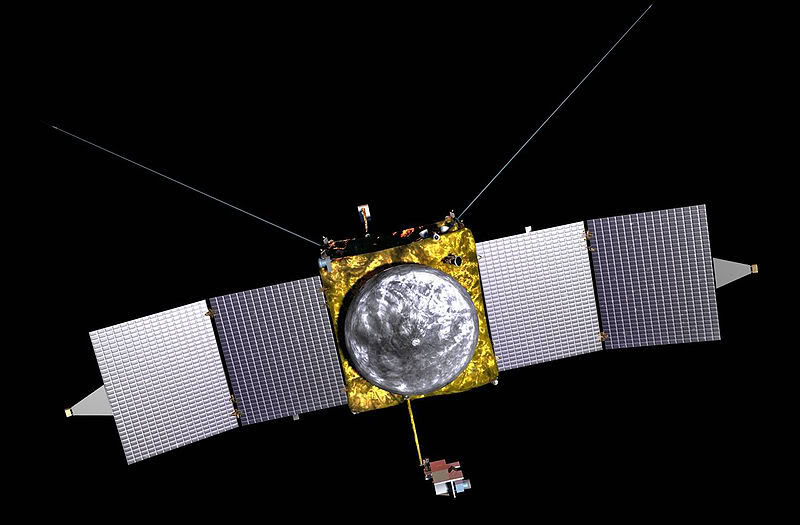
The Maven spacecraft was built by Lockheed Martin utilizing heritage components and techniques that are flying on the Mars Reconnaissance Orbiter and the Juno Spacecraft, both also built by LM. MAVEN consists of a cubical spacecraft platform that hosts the bulk of spacecraft systems and payloads some of which are mounted on deployable instrument booms. Also attached to the main platform are two deployable solar arrays that also host scientific instruments.
The cubical satellite platform is 2.3 by 2.3 by 2 meters in size, consisting of aluminum honeycomb sandwiched between graphite composite face sheets. The core of the structure is a 1.3-meter diameter cylinder that encloses the propellant tank of the spacecraft.
Mounted radially on the cylinder are composite sheets that are attached using metal fittings. The cylinder, the radial sheets and the exterior panels are used as mounting platforms for spacecraft equipment and serve as load-bearing structure.
The primary structure has a mass of 125 Kilograms and is capable of supporting the entire mass of the spacecraft and loads experienced during launch. MAVEN has a dry weight of 809 Kilograms.
Overall, MAVEN is 3.47 meters high, 2.29 meters wide and 11.43 meters long with its two large solar panels deployed. At launch, the spacecraft weighs 2,454 Kilograms.
The large propellant tank located inside the central tube holds the entire Hydrazine supply for the MAVEN mission. It was manufactured by ATK Aerospace Group, California, and is 1.83 meters tall, capable of holding 1,640 Kilograms of Hydrazine monopropellant for use by the vehicle’s propulsion system.
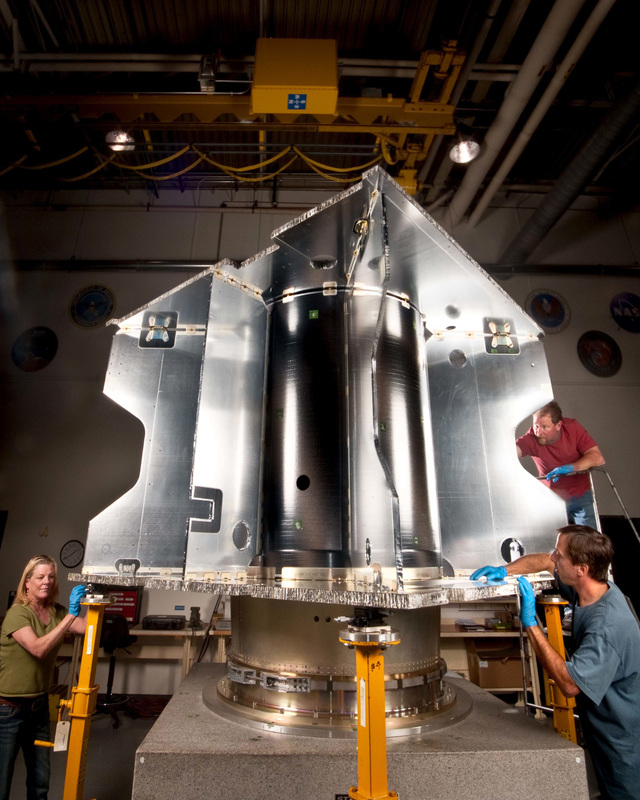
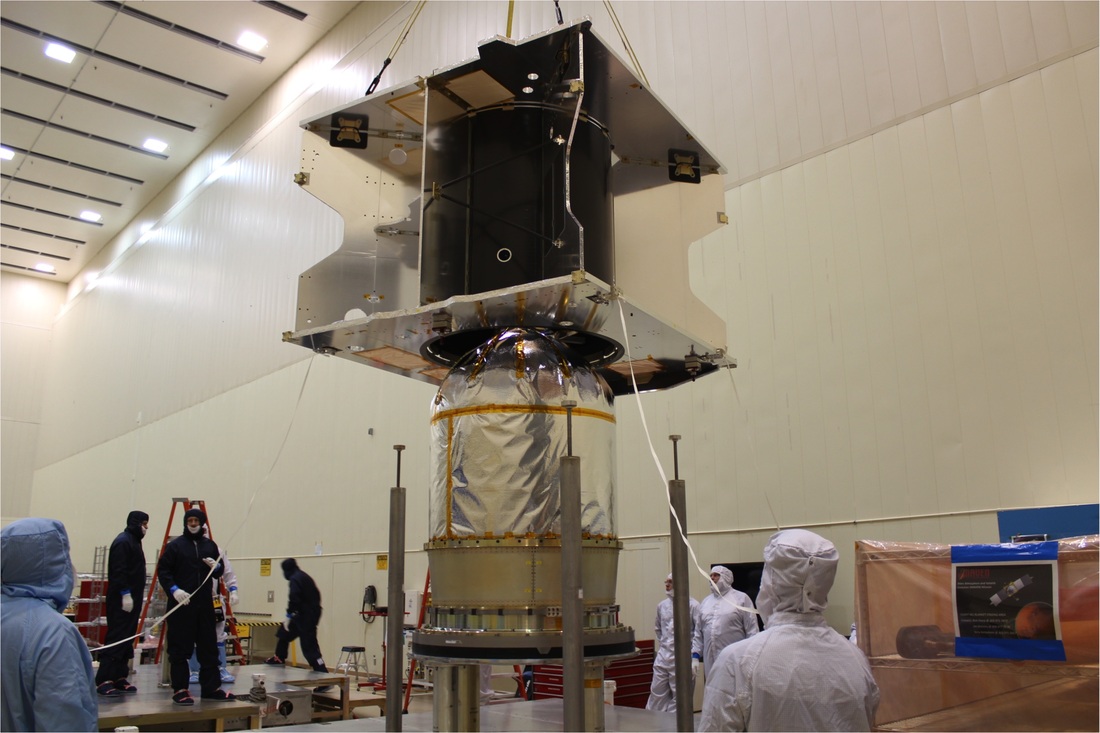
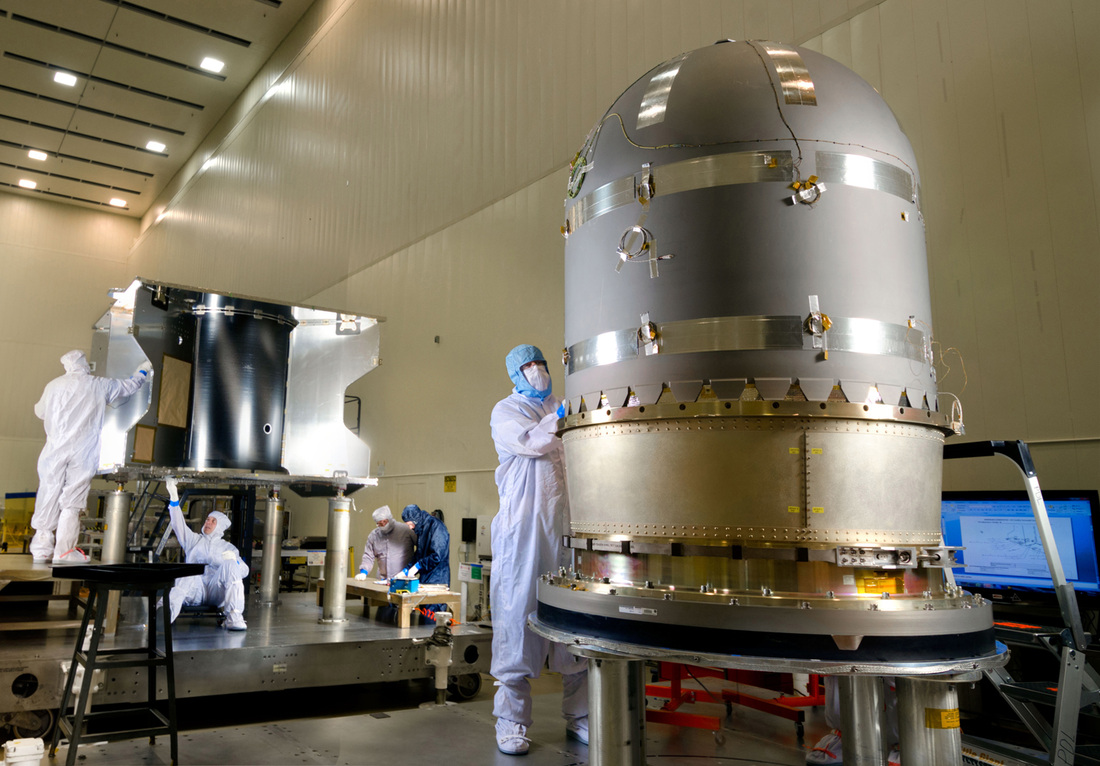
Propulsion System
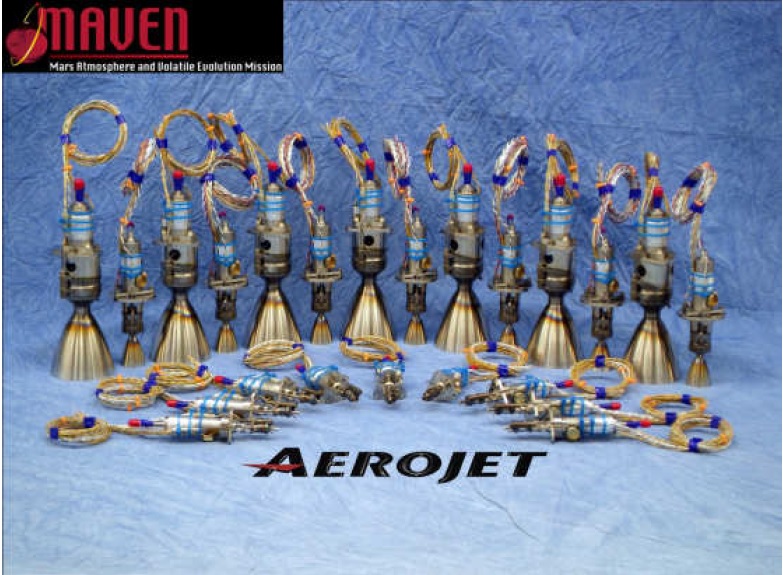
MAVEN’s propulsion system is based on the system developed for the Mars Reconnaissance Orbiter. The Aerojet-manufactured propulsion system uses a total of 20 thrusters that are divided in three groups – a bank of six main propulsion thrusters, six medium-thrust engines and eight attitude control thrusters. All engines are catalytic thrusters using Hydrazine monopropellant.
MAVEN is equipped with a total of six MR-107N thrusters installed on the base of the spacecraft. Each of these engines provides a nominal thrust of 170 Newtons with a throttle capability of 109 to 296 Newtons. With the six engines at nominal throttle, MAVEN has a total thrust of 1,020 Newtons – 104 Kilogram-force.

MR-107N operates at a propellant feed pressure of 8.2 to 27.8 bar and a chamber pressure of 4.2 to 11.2 bar to create a specific impulse of 229 to 232 seconds. The engine ingests 49 to 131 grams of fuel per second depending on the thrust setting. It has a expansion ratio of 20.7. MR-107N weighs 740 grams, measuring 22 centimeters in length and 6.6 centimeters in diameter. It uses a Moog Single Seat Valve. The engine is certified for nearly 1,500 duty cycles.
The main propulsion system is used by the MAVEN spacecraft for its first large Trajectory Correction Maneuver and the crucial Mars Orbit Insertion Maneuver as well as any other large maneuvers requiring a large delta-v. MAVEN’s propellant system operates in regulated mode for main engine burns and in blowdown mode for attitude maneuvers using the smaller thrusters. Helium is used for tank pressurization.
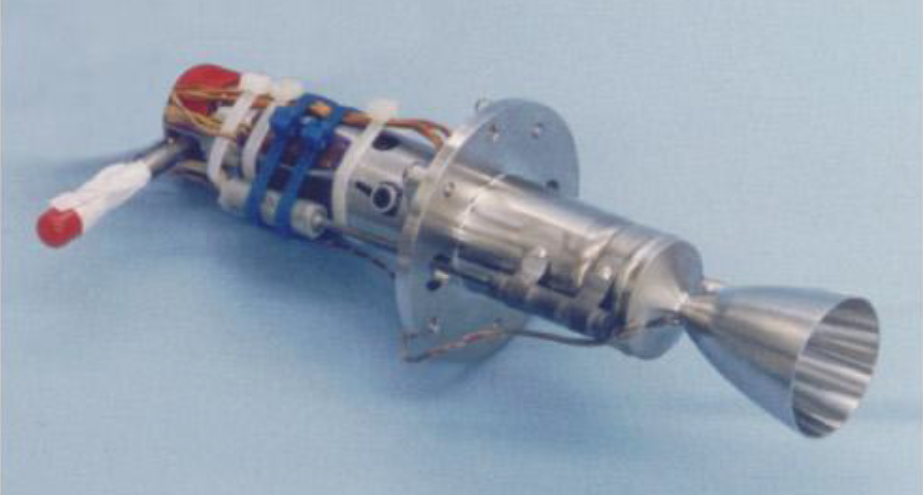
In addition to its main propulsion system, MAVEN is equipped with six MR-106E thrusters that are used for smaller Trajectory Corrections, Orbit Adjustment Maneuvers and to provide attitude control during main engine burns such as the insertion maneuver.
MR-106E provides 22-Newtons of thrust with an operational range of 11.6 to 30.7 Newtons operating at a feed pressure of 6.9 to 24.1 bar and chamber pressure of 4.5 to 12.4 bar.
The thruster provides a specific impulse of 229 to 235 seconds. It has an expansion ratio of 60 and consumes 5.0 to 13.1 grams of propellant per second. MR-106E weighs 635 grams with a length of 18.2 centimeters and a nozzle diameter of 3.4 centimeters. The 22N thruster uses a Dual Seat prop valve. It is certified for more than 50,000 duty cycles and long firings of up to 2,000 seconds as well as a cumulative burn time of 4,670 seconds.
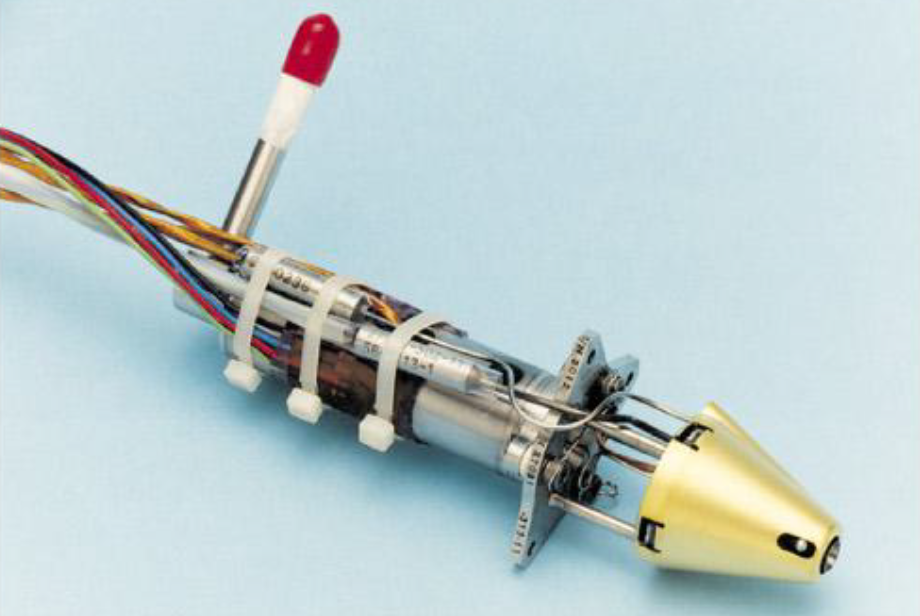
For smaller attitude control maneuvers, MAVEN features eight MR-103D thrusters each providing a low thrust of 1 Newton with an operational range of 0.22 to 1.02 Newtons. MR-103D operates at a propellant feed pressure of 6.2 to 27.6 bar and a chamber pressure of 5.9 to 23.4 bar as the engine uses 0.09 to 0.5 grams of Hydrazine per second.
The engine has an expansion ratio of 100 being 14.6 centimeters long with a mass of 330 grams and a diameter of 3.4 centimeters. A Dual Seat Valve is also used on this engine that provides a specific impulse of 209 to 224 seconds. MR-103D is certified for 275,000 duty cycles and a cumulative burn time of 111 hours along with a single firing certification of 5,000 seconds.
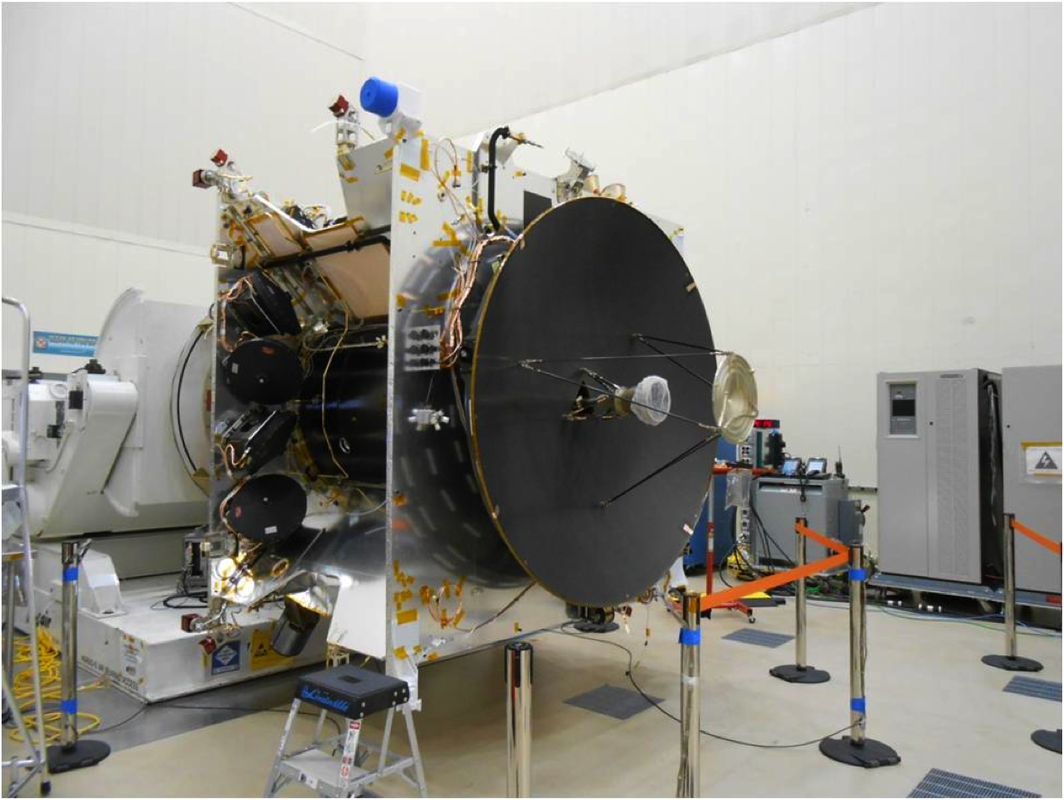
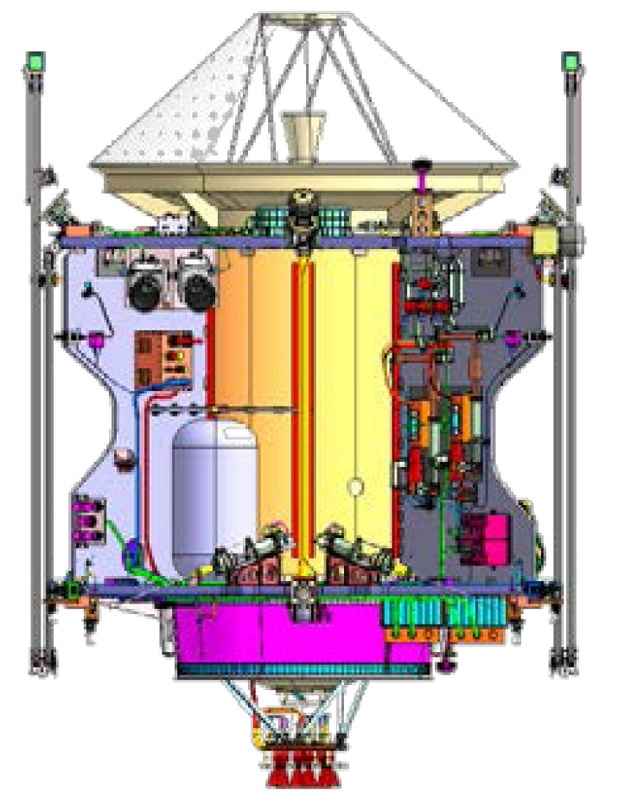
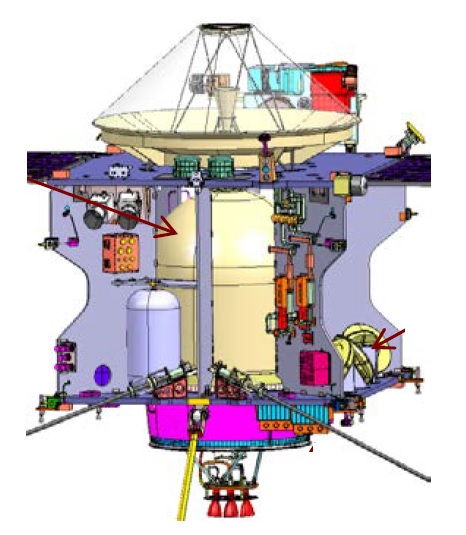
Navigation and Attitude Control
MAVEN is equipped with a redundant sun sensor system that is used to calculate the position of the sun to point the vehicle’s solar arrays toward the sun in case of vehicle safe mode to maintain stable power generation.
Two star trackers provide the precise navigation and orientation data to MAVEN’s onboard computer. Star tracker data is used for precise pointing toward Earth for communications, to the sun for battery charging and to Mars for science operations. The star trackers provide ten images per second that are then compared with a catalog of thousands of stars to determine the vehicle’s orientation in space.
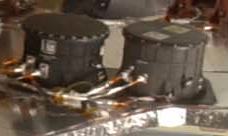
A redundant system of two Inertial Measurement Units is also installed on the spacecraft. Each unit consists of three ring-laser gyroscopes and three accelerometers – one gyro and one accelerometer for each axis to measure. The IMU is used to precisely determine accelerations on the vehicle during engine burns and vehicle rates during attitude changes to provide precise pointing capability. Accelerometer data can also be used to measure atmospheric density in the uppermost portion of the Martian atmosphere as drag forces become noticeable to the spacecraft.
Navigation data provided by the sensor complement is used by the vehicle’s flight computer to actuate the vehicle’s attitude control system. For larger attitude maneuver, MAVEN uses its small 1-Newton thrusters while standard vehicle pointing and attitude control its accomplished by four Reaction Wheels – three for each rotational axis plus one spare.
The wheels are spun by electric motors at variable speed that is changed when making attitude maneuvers. Each Reaction Wheel assembly weighs 10 kilograms and the wheels spin as fast as 6,000 rpm. The thrusters are used for periodic angular momentum desaturation – slowing down the reaction wheels and countering the resulting force with the thrusters so that the wheels can then be accelerated during standard attitude operations.
Flight Computer & Data System
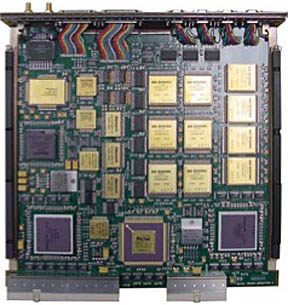
MAVEN is equipped with a RAD-750 Central Processing Board that is a single-card computer manufactured by BAE Systems in Manassas, Va. The processor can endure radiation doses that are a million times more extreme than what is considered fatal to humans. The RAD750 CPU itself can tolerate 200,000 to 1,000,000 rads. Also, RAD750 will not suffer more than one event requiring interventions from Earth over a 15-year period.
“The RAD750 card is designed to accommodate all those single event effects and survive them. The ultimate goal is one upset is allowed in 15 years. An upset means an intervention from Earth — one ‘blue screen of death’ in 15 years. We typically have contracts that (specify) that,” said Vic Scuderi BAE Business Manager.
RAD-750 was released in 2001 and made its first launch in 2005 aboard the Deep Impact Spacecraft. The CPU has 10.4 million transistors. The RAD750 processors operate at up to 200 megahertz, processing at 400 MIPS. The CPU has an L1 cache memory of 2 x 32KB (instruction + data) – to improve performance, multiple 1MB L2 cache modules can be implemented depending on mission requirements.
RAD750 operates at temperatures of -55°C to 125°C with a power consumption of 10 Watts. The standard RAD750 system can tolerate 100,000rads.
The Data Handling System receives data from the payload and can send commands to the payloads as part of stored operational sequences. Data from the navigation sensors are also processed by the Data Handling Systems that in turn command the attitude control system and propulsion systems of the vehicle. Housekeeping operations such as the commanding of heaters based on temp sensor data and power management is also accomplished by the computer system.
The Mass Memory Board directly interfaces with the Telecom system of the spacecraft for data downlink and command uplink.
Communications System
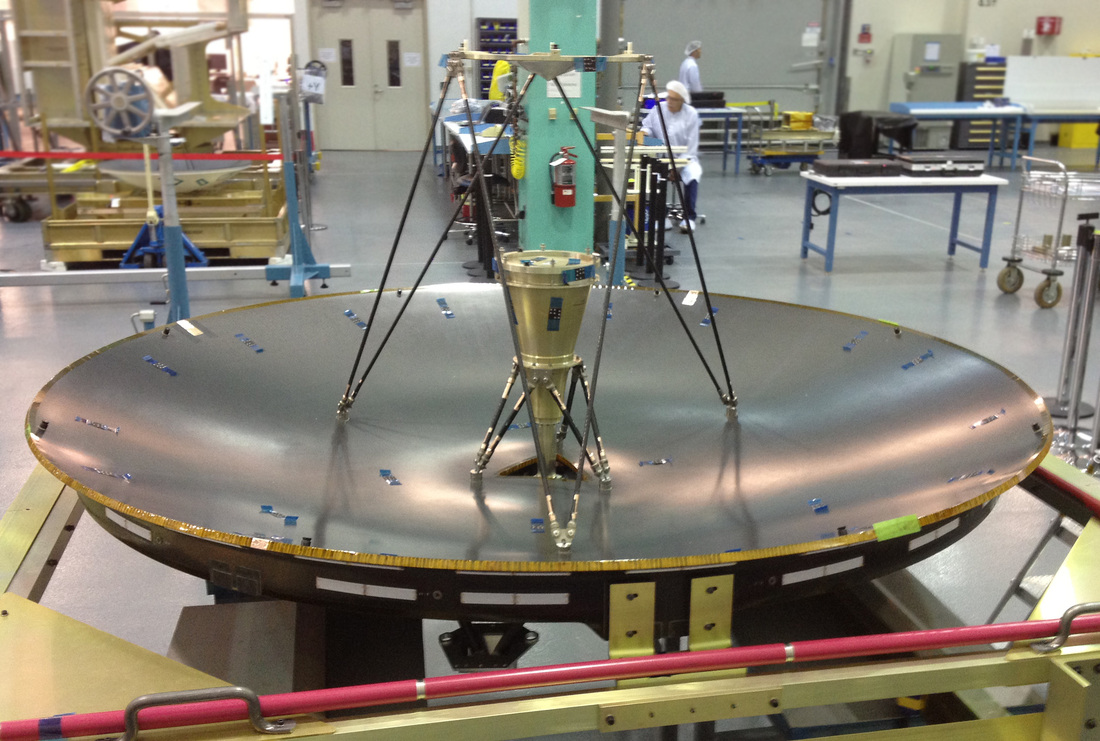
The MAVEN spacecraft features a high-gain communications system as well as a low-gain system.
MAVEN’s high gain antenna is fixed on the +Z axis of the spacecraft and can not be moved to track Earth by itself. The antenna is a 2.1-meter diameter dish with a dual-reflector X-Band system to achieve downlink data rates of up to 550kb/s. It is made of a Kevlar honeycomb core between two composite face sheets. The HGA features Traveling Wave Tube Amplifiers to generate a strong signal that can be picked up by Deep Space Network Stations on Earth.
Because the high-gain antenna is fixed on the spacecraft, the whole MAVEN spacecraft has to be moved to point the antenna at Earth for its regular communications sessions that are expected to be five hours in duration, twice a week when the vehicle is taking a break from science operations.
The low-gain system does not require any attitude changes as the two low gain antennas on the MAVEN spacecraft achieve omni-directional coverage at very low data rates. The low-gain system can be used to command uplink and downlink of low data rate telemetry such as tones that are used during Mars Orbit Insertion.
Electra UHF Terminal
In addition to its X-Band communications system to transmit signals to Earth and receive signals from home, MAVEN is equipped with an Electra UHF Communications Terminal. Electra has been used on a number of previous Mars missions and has become the standard system used to relay data from Mars rovers.
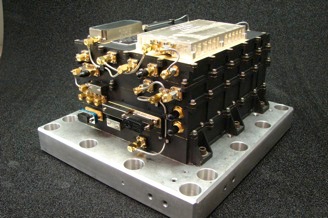
The Electra terminal consists of dual string UHF Transceivers, dual string Ultrastable Oscillators for precision navigation and surface positioning and a low gain UHF antenna pointing nadir. The EUT (Electra UHF Transceiver) is the core of the payload.
It is a fully-reconfigurable, frequency-agile transceiver that operates in a frequency range of 390 to 450 MHz. EUT is comprised of four stacked platforms as part of a modular design approach – a Filtering and Switching Unit, a Receiver/Modulator, a Baseband Processor Module and a power Amplifier Power Supply Module.
The oscillators provide a stable frequency reference to the EUT and the Small Deep Space Transponder as well as a one-way Doppler ranging capability. Also, it provides a stable time reference to the spacecraft that is used to synchronize onboard clocks for proper time-tagging of science and telemetry data.
The Electra UHF antenna is a quadrafilar helix with previous flight heritage.
The Electra Unit is 17 by 22 by 14 centimeters in size weighing 4.9 Kilograms enclosed in a gold plated magnesium chassis. Thermal control is provided by heat rejection through the base installation plate of the unit.
As a Mars Orbiter passes within the field of view of a lander or rover, the two Electra units on the two vehicles establish a communications link. Based on the geometry of any given pass, the spacecraft Electra unit monitors the signal strength of the ground-based terminal to command it to different data rates during the pass based on the distance between the two. Data rates can be as low as 1kb/s and as high as 2,048kb/s in favorable conditions. Data that is received by the Electra system is then stored aboard the orbiter for downlink to the ground using its high-gain X-Band system.
This enables rovers to downlink large data volumes including science data, images and vehicle telemetry that could not be downlinked via their own communication system that can only achieve a fraction of the orbiter’s direct to Earth communications data rate.
Despite its elliptical orbit, MAVEN has been deemed a good orbiter for UHF data relay, but providing Comm Relay during its science mission would reduce the science return of the mission. That is why MAVEN demonstrates a full end-to-end demonstration of Comm Relay before starting science operations.
The primary science mission does not feature any planned relay operations as MAVEN serves as backup to the Mars Reconnaissance Orbiter and Mars Odyssey. In the extended science mission, teams expect to make room for both, science and communications relay
Power System
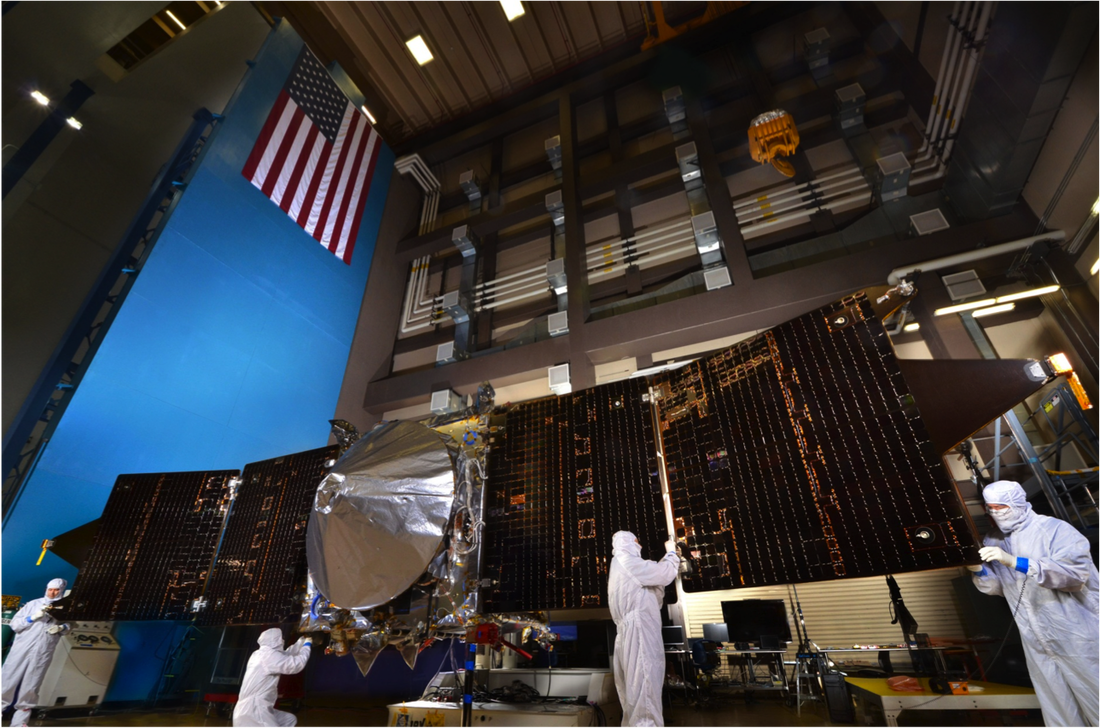 MAVEN features two deployable solar arrays, each consisting of two panels. The solar arrays are fixed and sun-pointing is accomplished by changing the vehicle’s attitude. The outer panels are installed at a 20-degree gull wing angle to the inner panels to provide aerostability to the spacecraft when it flies through the uppermost portion of the Martian Atmosphere.
MAVEN features two deployable solar arrays, each consisting of two panels. The solar arrays are fixed and sun-pointing is accomplished by changing the vehicle’s attitude. The outer panels are installed at a 20-degree gull wing angle to the inner panels to provide aerostability to the spacecraft when it flies through the uppermost portion of the Martian Atmosphere.
Installed on the two outer solar panels are two wedge-shaped diving boards that facilitate the magnetometers of the spacecraft. With the solar arrays deployed, MAVEN spans 11.43 meters from tip to tip.
The two solar arrays provide about 1,200 Watts of electrical power that is stored in two 55-Amp-hour batteries. Dedicated electronics distribute electrical power and control the state of charge of the two batteries. MAVEN uses a 28-Volt main power bus.
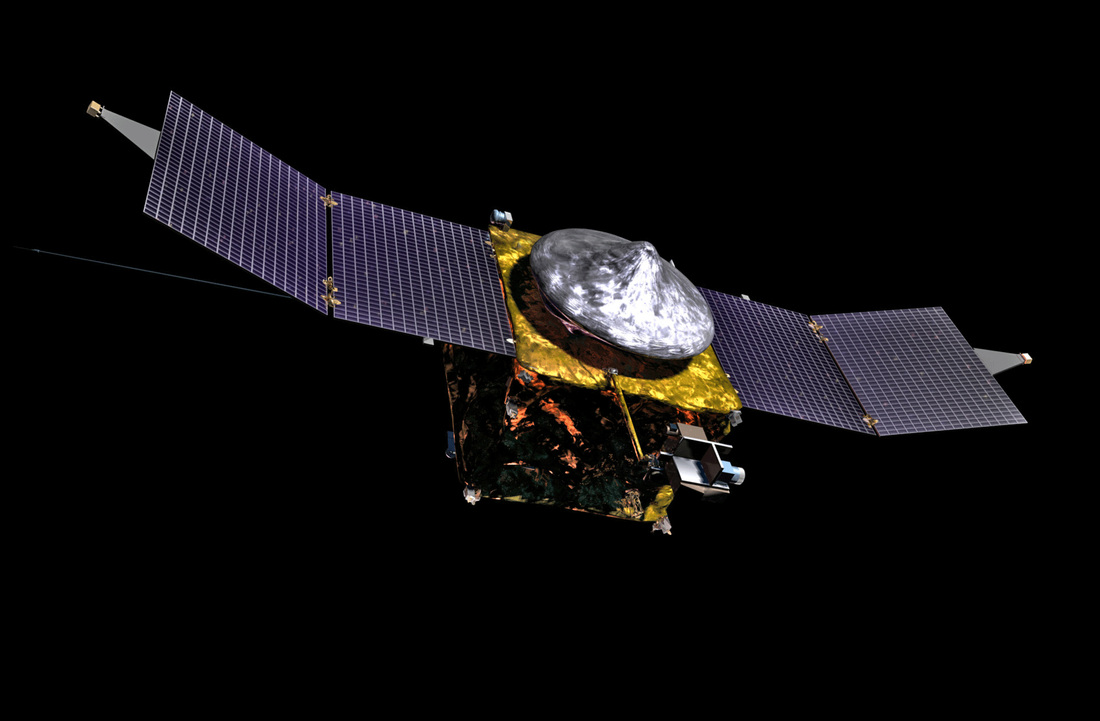
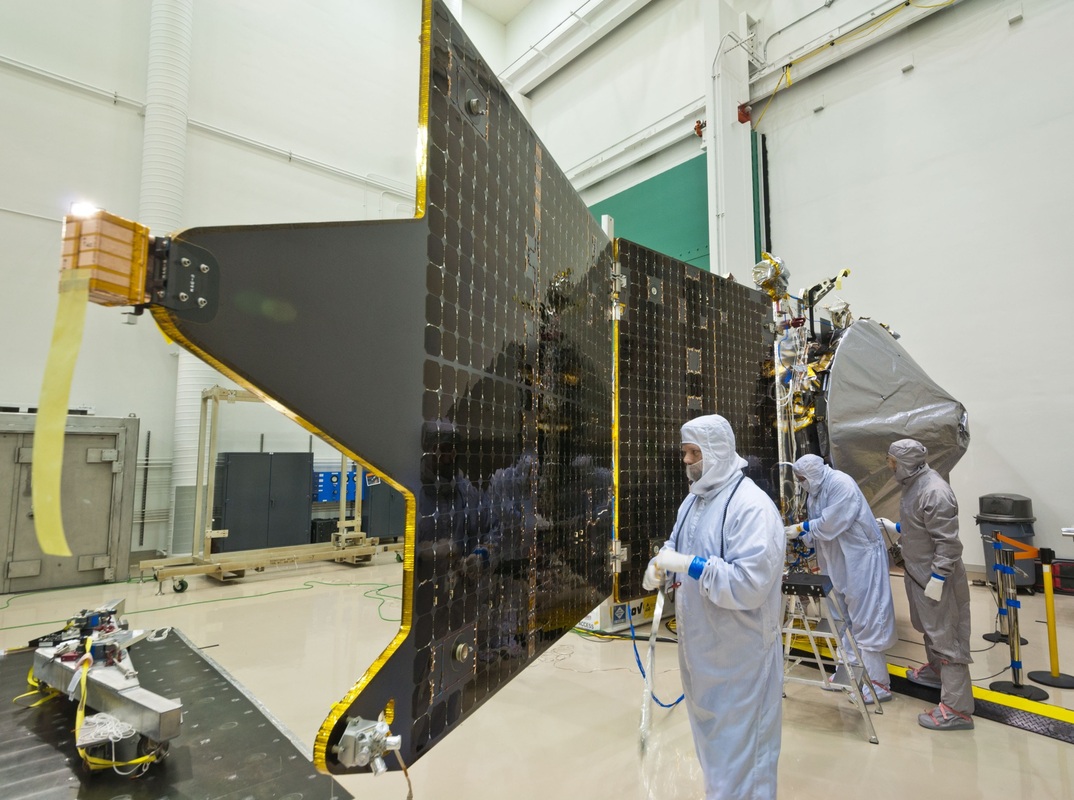
Articulated Payload Platform
MAVEN has an Articulated Payload Platform installed on a boom to facilitate the IUVS, STATIC and NGIMS instruments. The platform can be pointed independently to allow its instruments to gather science data in a variety of spacecraft orientations. The platform is equipped with an inner and an outer gimbal. The Articulated Payload Platform can be moved +/-90 degrees in elevation and has a +/-177.5-degree azimuth travel.
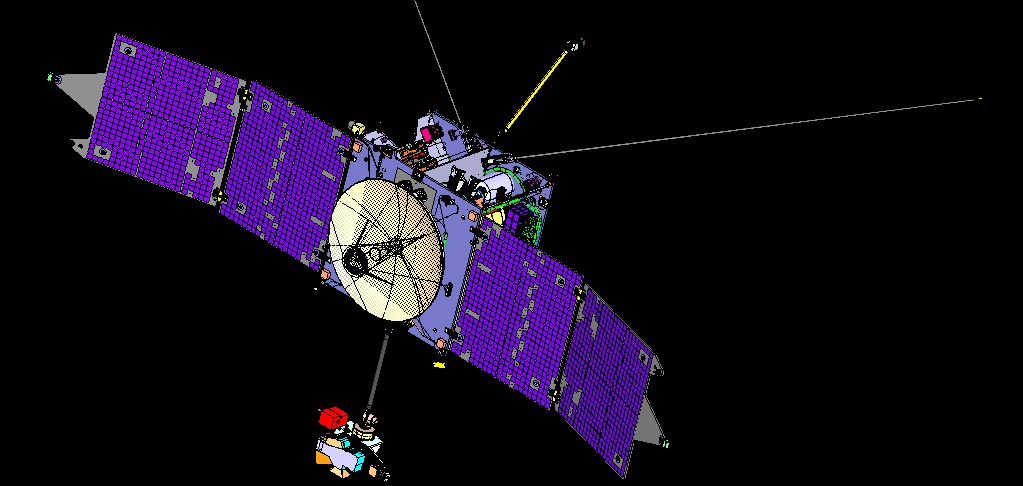
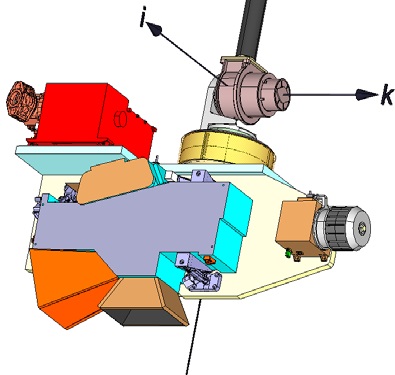
Instruments
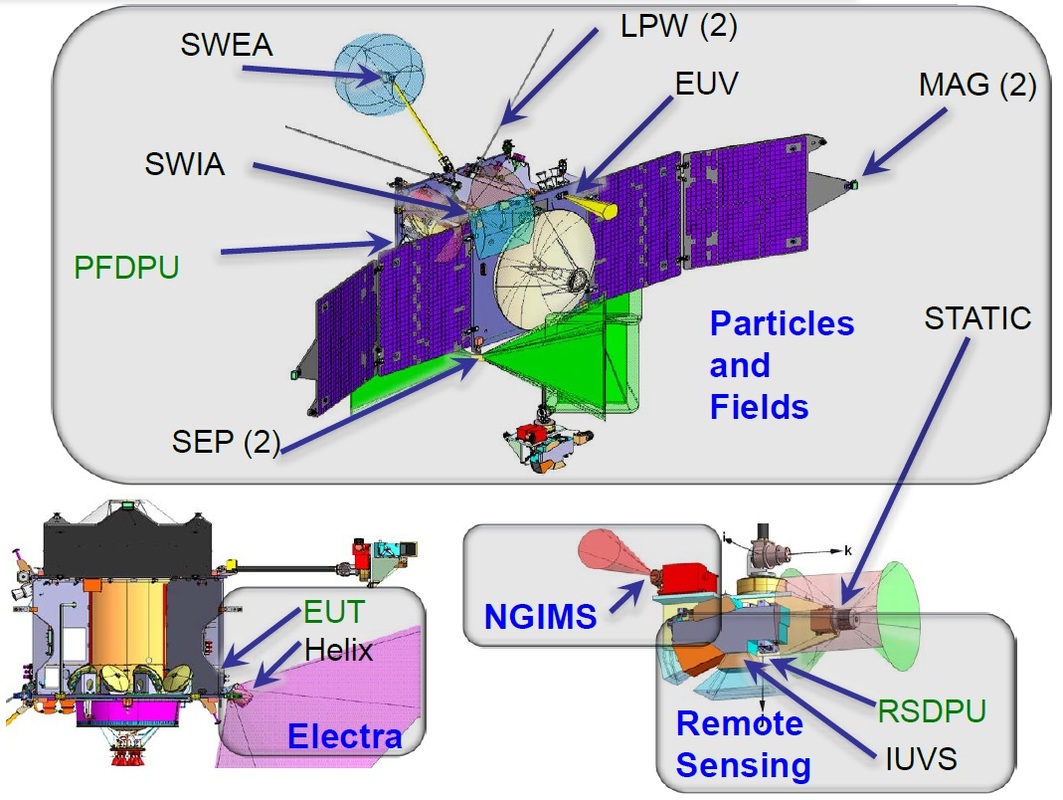
The MAVEN Spacecraft carries a total of eight instruments:
- SupraThermal And Thermal Ion Composition (STATIC)
- Solar Energetic Particle (SEP)
- Solar Wind Electron Analyzer (SWEA)
- Solar Wind Ion Analyzer (SWIA)
- Langmuir Probe and Waves (LPW)
- Magnetometer (MAG)
- Neutral Gas and Ion Mass Spectrometer (NGIMS)
- Imaging Ultraviolet Spectrometer (IUVS)
